Overview
This article presents ten essential tips for selecting the right preparative HPLC column, underscoring the critical factors that influence performance. Key considerations include:
- Particle size
- Column length
- Stationary phase
- Mobile phase composition
- Flow rate
- Temperature control
- Maintenance
- Detector choice
- The value of expert consultation
Each tip is enriched with insights and recommendations that elucidate how these elements affect separation efficiency and resolution in high-performance liquid chromatography applications. By understanding these factors, laboratory professionals can significantly enhance their analytical capabilities and ensure optimal outcomes.
Introduction
Choosing the right preparative HPLC column is a critical decision that can significantly impact the efficiency and reliability of analytical results. With advancements in chromatography technology and a myriad of options available, researchers face the challenge of navigating through complex specifications and performance metrics. This article offers ten essential tips designed to empower laboratory professionals to make informed choices, ensuring optimal separation and enhanced accuracy in their applications.
How can one strike the perfect balance between performance and practicality in selecting the ideal HPLC column?
JM Science: Premium Preparative HPLC Columns for Optimal Performance
JM Science Inc. presents an extensive array of high-quality preparative liquid chromatography materials, prominently featuring the esteemed Capcell Pak series, meticulously engineered for optimal performance across a multitude of applications. These structures are specifically designed to deliver exceptional clarity and effectiveness, making them ideal for complex separations in pharmaceutical and analytical laboratories.
In addition to chromatography solutions, JM Science offers a comprehensive selection of titrators, Karl Fischer reagents, and chromatography fittings, ensuring that laboratory needs are thoroughly met. Recent advancements in technology for the preparative HPLC column have further enhanced their capabilities, guaranteeing that these systems satisfy the stringent demands of contemporary scientific research and development.
Notably, research indicates that the use of high-performance liquid chromatography tubes can boost analysis efficiency by up to 30%, significantly benefiting pharmaceutical applications where precision is paramount.
With a steadfast , competitive pricing, and robust customer support, JM Science is devoted to delivering solutions that not only meet but surpass the expectations of researchers and laboratory professionals.
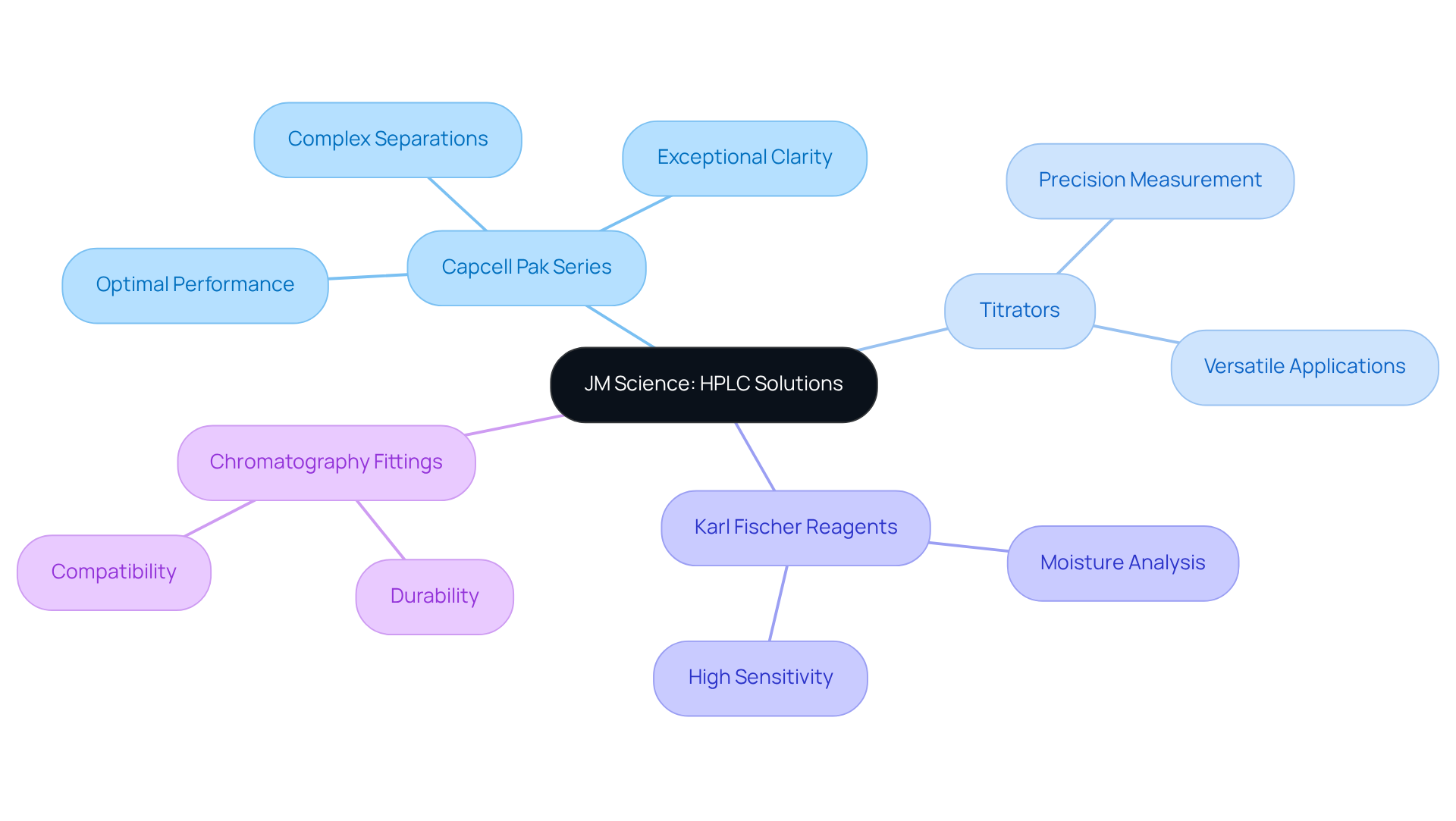
Consider Particle Size: Optimize Separation Efficiency in Preparative HPLC
When selecting a preparative HPLC column, the choice of is paramount, as it significantly influences the efficiency of separation. Smaller particles generally improve resolution and decrease analysis times due to their larger surface area, which promotes increased interactions between analytes and the stationary phase. However, this advantage comes with a trade-off: smaller particles generate higher backpressure levels, potentially stressing the high-performance liquid chromatography system and necessitating more robust equipment.
For example, average backpressure levels can fluctuate considerably based on particle size; sub-2 μm particles often produce pressures that surpass the operational limits of standard systems. Thus, finding a balance between achieving optimal separation and maintaining manageable pressure levels is essential. Recent studies demonstrate that optimizing particle size not only enhances chromatographic performance but also prolongs equipment longevity by mitigating wear and tear.
Experts advocate for a systematic approach to selecting particle size, considering both the specific application and the chromatographic system's capabilities, which can lead to significant improvements in analytical results. For instance, applications involving the separation of complex mixtures may benefit from smaller particles, while simpler extractions can be effectively performed with larger particles, thereby reducing backpressure and extending column life.
Ultimately, understanding the interplay between particle size, backpressure, and efficiency is crucial for laboratory managers aiming to refine their processes using a preparative HPLC column. As Krisztián Horváth noted, 'Wide particle size distributions have a significant impact on the efficiency of separation.' Therefore, laboratory managers should meticulously assess their specific applications and equipment capabilities when selecting particle sizes to ensure optimal performance.
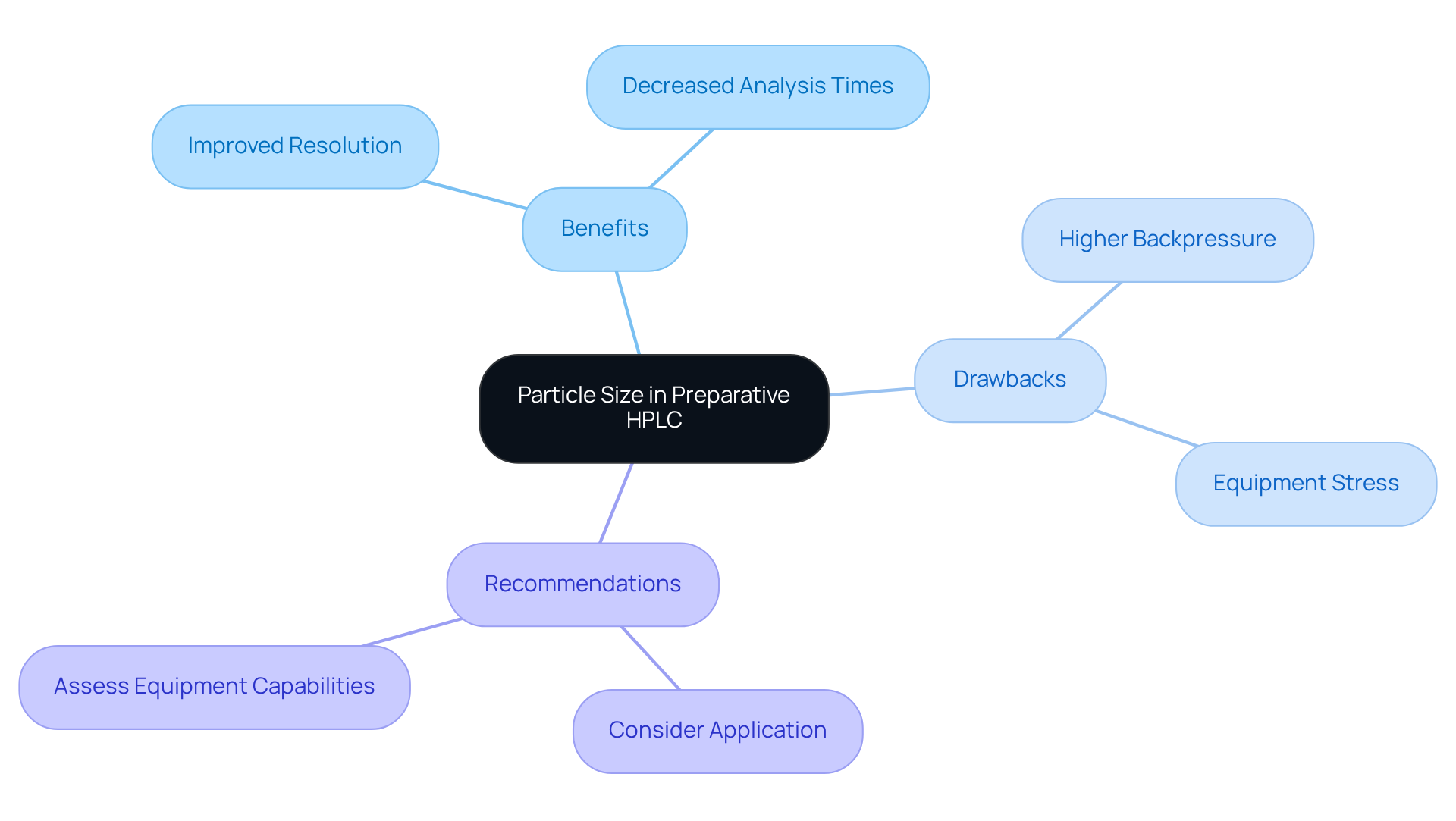
Evaluate Column Length: Balance Resolution and Throughput in HPLC
The length of an HPLC tube is pivotal in establishing the clarity of divisions. Extended sections typically enhance resolution by allowing greater interaction time between analytes and the stationary phase. Research indicates that doubling the length of the segment from 100 mm to 200 mm can lead to a 40% increase in peak capacity, significantly improving the separation of closely eluting compounds. However, this increase in length also extends analysis time, which may negatively impact throughput.
In preparative applications, it is crucial to select a preparative HPLC column length that balances high resolution with efficient sample processing. Industry experts underscore that optimizing throughput while ensuring adequate resolution is a common challenge faced by chromatographers. For instance, automated high-performance liquid chromatography method development has shown potential in enhancing throughput without sacrificing resolution, particularly in intricate mixtures.
Ultimately, the should be guided by specific analytical goals, taking into account both the nature of the samples and the desired level of detail in differentiation.
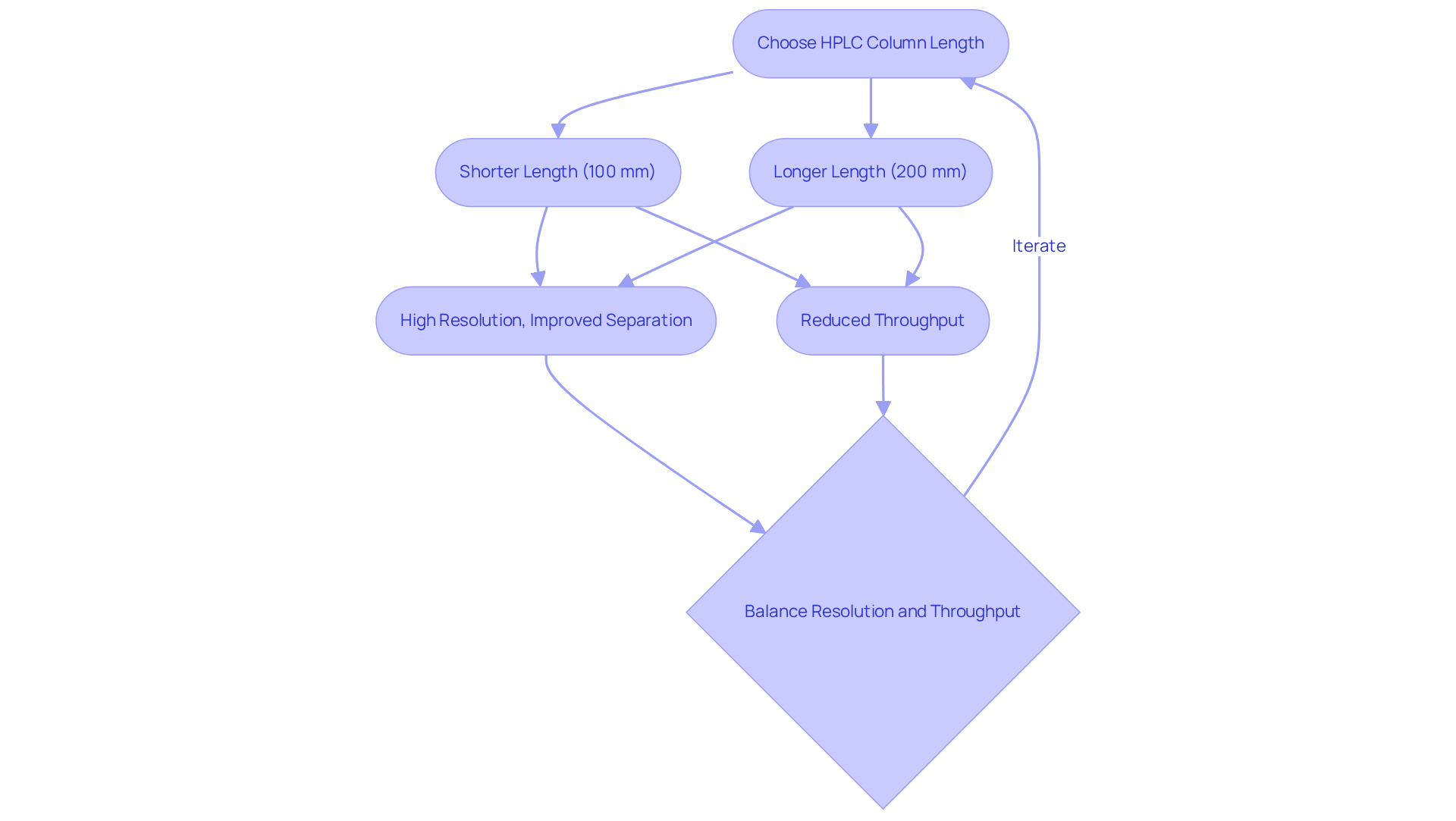
Select Stationary Phase: Tailor Your HPLC Column to Target Compounds
Selecting the appropriate preparative HPLC column is crucial for achieving efficient separations. The is significantly influenced by their chemical characteristics, making it essential to understand these dynamics. For instance, C18 materials are predominantly employed for non-polar compounds due to their hydrophobic nature, while phenyl materials offer enhanced selectivity for aromatic compounds through π-π interactions.
Notably, recent trends in 2025 reveal a growing preference for zwitterionic and polar stationary materials, which deliver high efficiency and improved retention for polar analytes, particularly in complex mixtures. Statistics indicate that C18 columns are the most commonly utilized in pharmaceutical applications, accounting for over 70% of chromatographic processes, underscoring their reliability.
Experts assert that the choice of stationary material profoundly impacts the quality of the separation, emphasizing the importance of tailoring the chromatographic column to the specific properties of the target compounds to achieve optimal results.
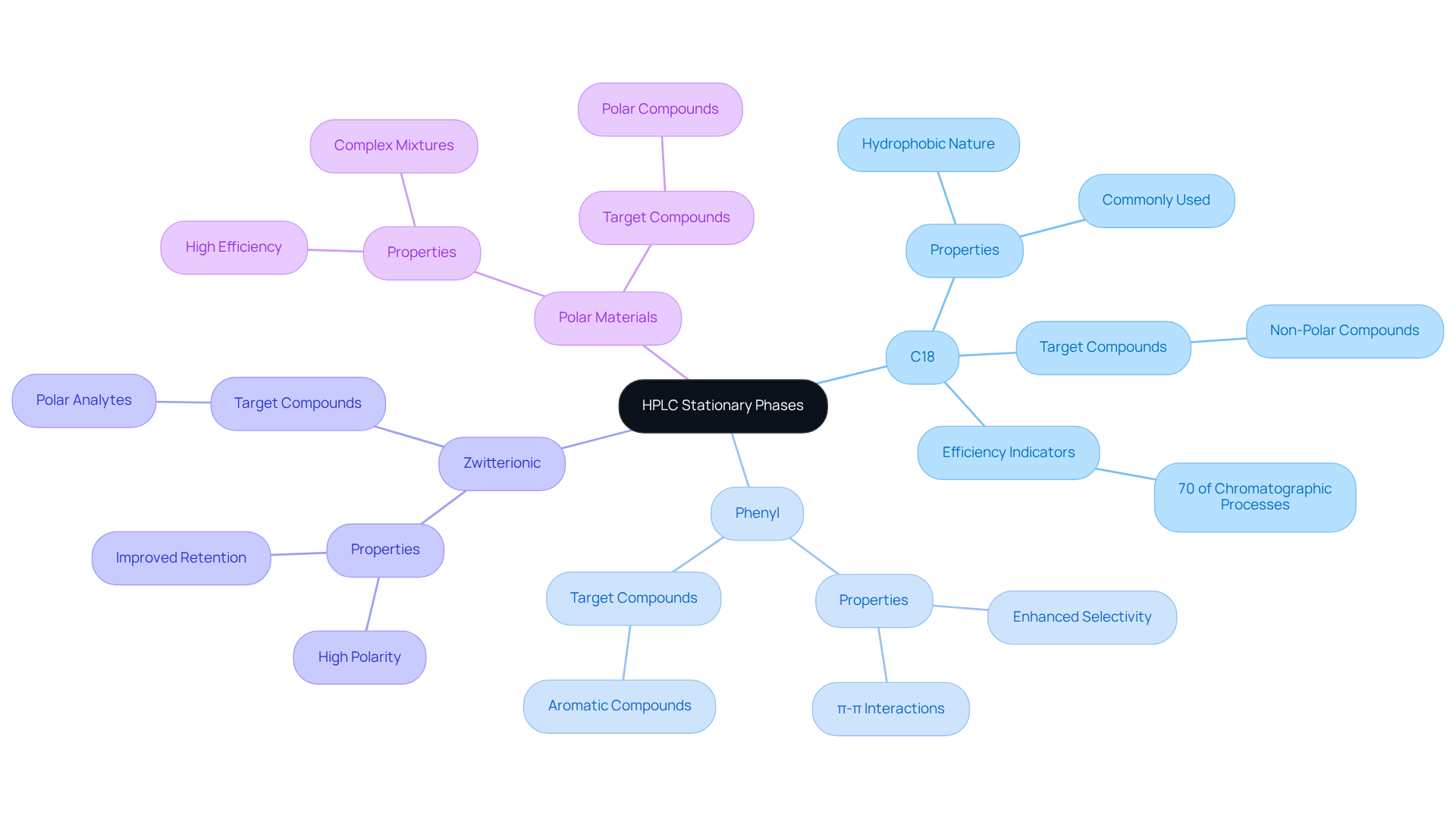
Analyze Mobile Phase Composition: Enhance Separation Outcomes
The composition of the mobile component is paramount in high-performance liquid chromatography (HPLC), as it directly influences the separation of analytes. Adjusting solvent ratios, particularly between water and organic additives like acetonitrile or methanol, can lead to significant enhancements in analytical outcomes. For instance, increasing the volume fraction of organic solvent typically results in reduced analyte retention. Recent research underscores that the elution strength of the water-organic solvent (W-OS) mixture plays a crucial role in optimizing retention behavior.
Moreover, the choice of solvent not only affects the solvation of the stationary phase but also alters the immediate environment of the analytes, which is essential for achieving the desired separation efficiency and resolution. Additionally, the pH of the mobile phase can influence the ionization state of analytes, further impacting retention times. Therefore, a meticulous analysis and are vital for maximizing chromatographic performance.
It is also critical to utilize high-performance liquid chromatography grade solvents to minimize background interference and prevent long-term damage to the system. Recent studies indicate that the most effective separations often require a careful balance of solvent ratios, highlighting the necessity for a strategic approach in method development.
Employing tools such as the solvent selectivity triangle can assist in making informed decisions regarding solvent mixtures, while being cognizant of the potential drawbacks of adding modifiers is crucial for maintaining system integrity.
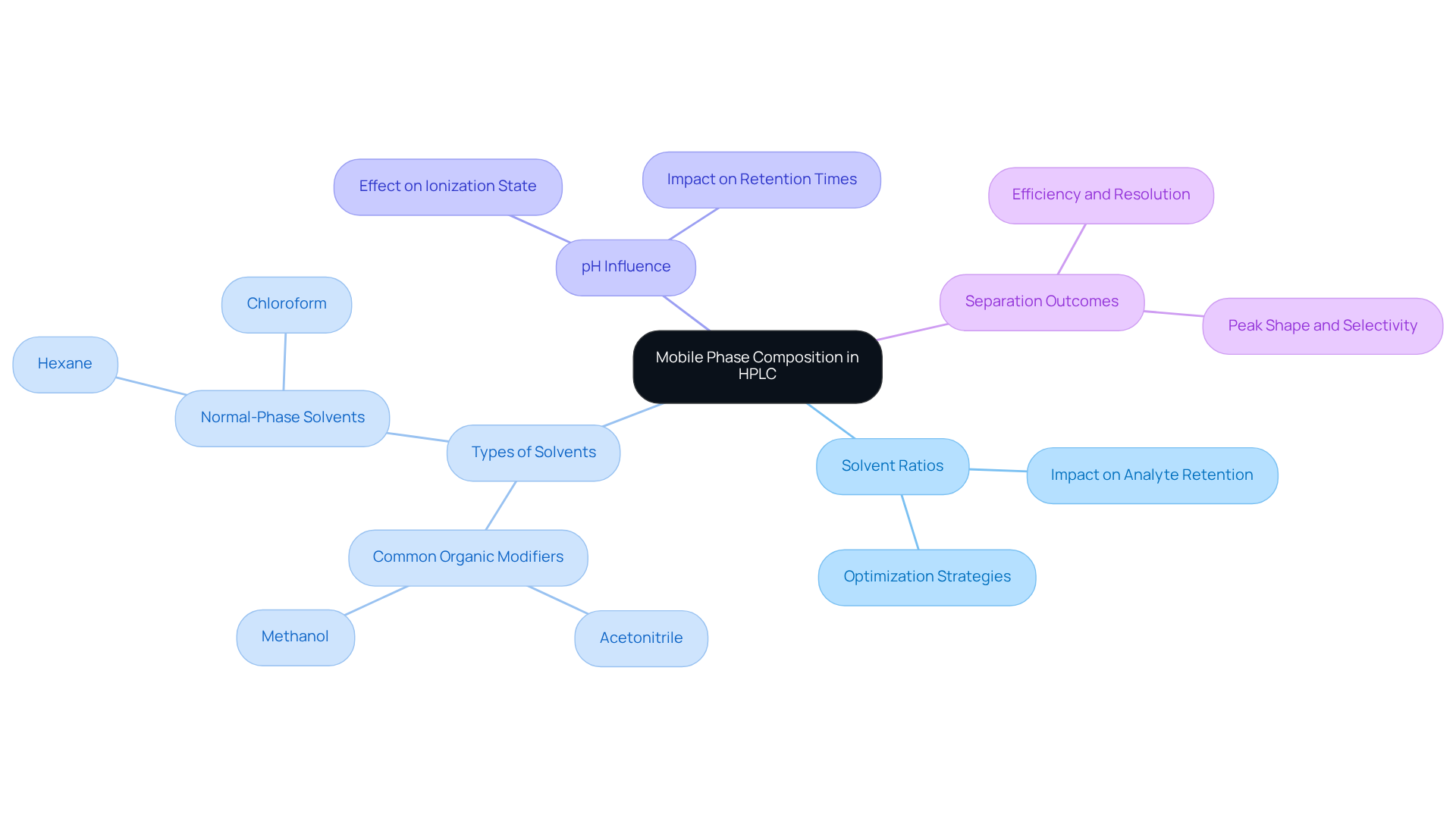
Adjust Flow Rate: Optimize HPLC Performance for Your Applications
Adjusting the flow rate in High-Performance Liquid Chromatography (HPLC) is essential for optimizing analytical performance. Increasing the flow rate can significantly reduce analysis time; however, this often leads to broader peaks and decreased resolution. A resolution of Rs ≥ 1.5 is typically regarded as adequate for baseline distinction, yet higher flow rates may compromise this standard. Conversely, lowering the flow rate generally narrows peaks and enhances the response factor, but it also extends the analysis time. Identifying the optimal flow rate that balances speed and resolution tailored to specific application requirements is therefore crucial.
Recent insights reveal that determining the right flow rate can maximize peak efficiency while minimizing overall run time. For instance, a case study focused on enhancing a drug impurity profile demonstrated that modifying the flow rate alongside a more suitable column type resulted in improved analyte distinction, achieving baseline resolution with Rs exceeding 1.5. Furthermore, adjusting mobile conditions can significantly enhance analytical outcomes, thereby improving assessment efficiency.
The impact of mobile composition and flow rate adjustments can be substantial. Increasing the aqueous phase in high-performance liquid chromatography can improve retention and facilitate better peak separation, while the use of buffering agents can control ionization, enhancing peak shape. As Kalvin Chen, co-founder of Mastelf Technologies, emphasizes, "Resolution is one of the most critical parameters in high-performance liquid chromatography because it determines how well two analytes are separated." Resolution (Rs) is mathematically defined by the retention times and peak widths of adjacent peaks, underscoring its significance in achieving optimal results. Thus, meticulous evaluation of is vital for attaining the best outcomes when using a preparative HPLC column in chromatography applications.
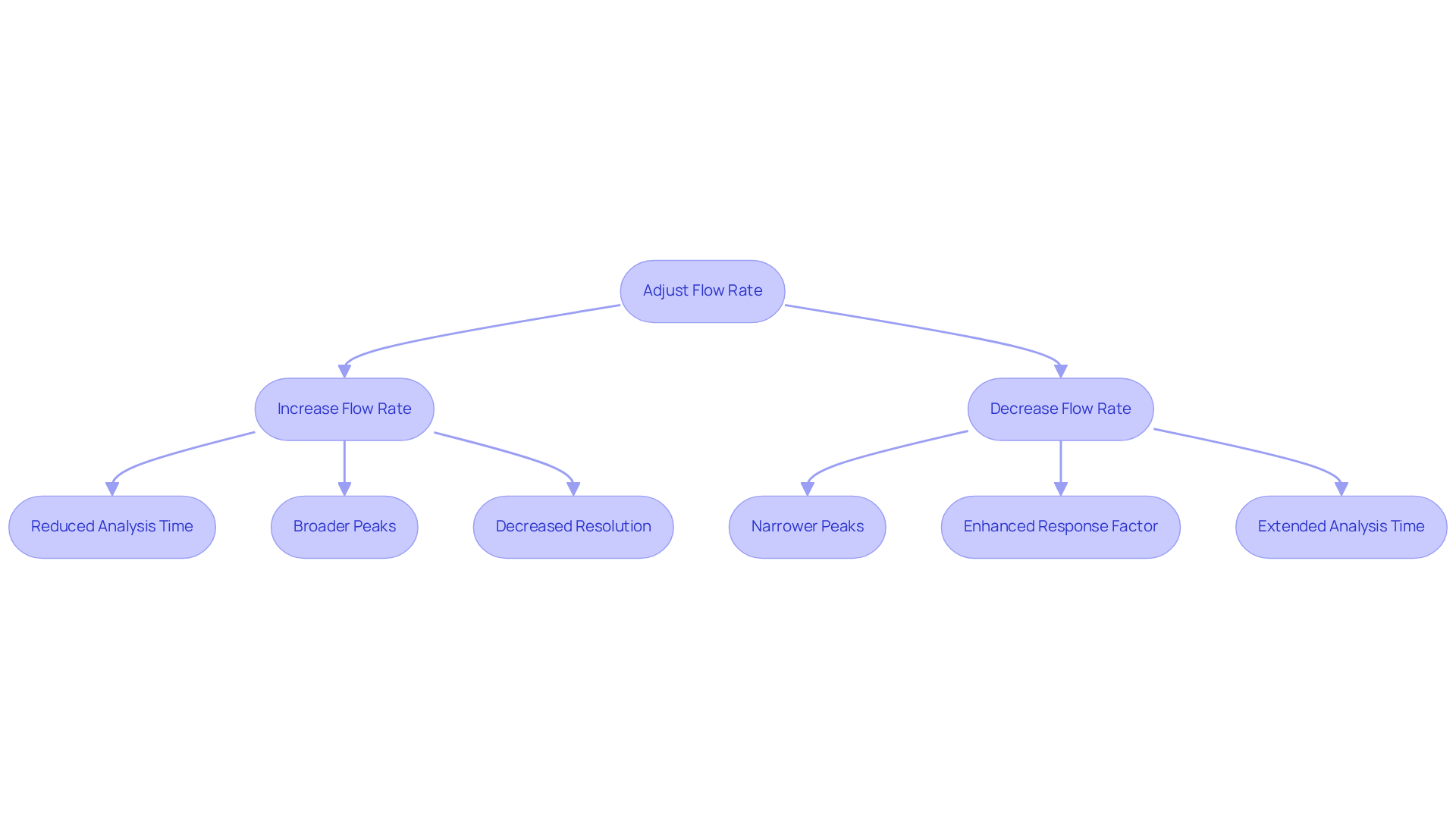
Control Temperature: Improve Consistency in HPLC Results
Temperature control in high-performance liquid chromatography (HPLC) is essential for achieving consistent and reproducible results. Variations in temperature can significantly , which in turn influences the interaction between analytes and the stationary medium. For example, elevated temperatures typically decrease mobile phase viscosity, resulting in lower backpressure and expedited analysis times. Operating at optimal temperatures not only enhances separation efficiency but also safeguards sensitive analytes from degradation.
Utilizing a vertical oven to maintain a stable temperature during analysis is a validated strategy that minimizes variability and boosts result reliability. Recent studies suggest that a temperature of approximately 40°C yields optimal chromatographic performance for superficially porous columns, improving both retention and selectivity. A study examining the effects of temperature gradients in liquid chromatography highlights that precise thermal management can significantly improve separation efficiency, reinforcing the necessity of maintaining consistent temperatures.
Furthermore, experts assert that a mere 1°C fluctuation in temperature can impact retention factors by 1-3%, as noted by Colin F. Poole. This underscores the sensitivity of HPLC results to temperature changes. Additionally, John Dolan advocates for pre-heating the mobile phase to prevent peak distortion, which occurs when a cooler mobile phase is introduced into a heated column, resulting in broader peaks rather than the desired Gaussian shape. Consequently, investing in reliable temperature control systems is crucial for laboratories striving for high-quality analytical outcomes.
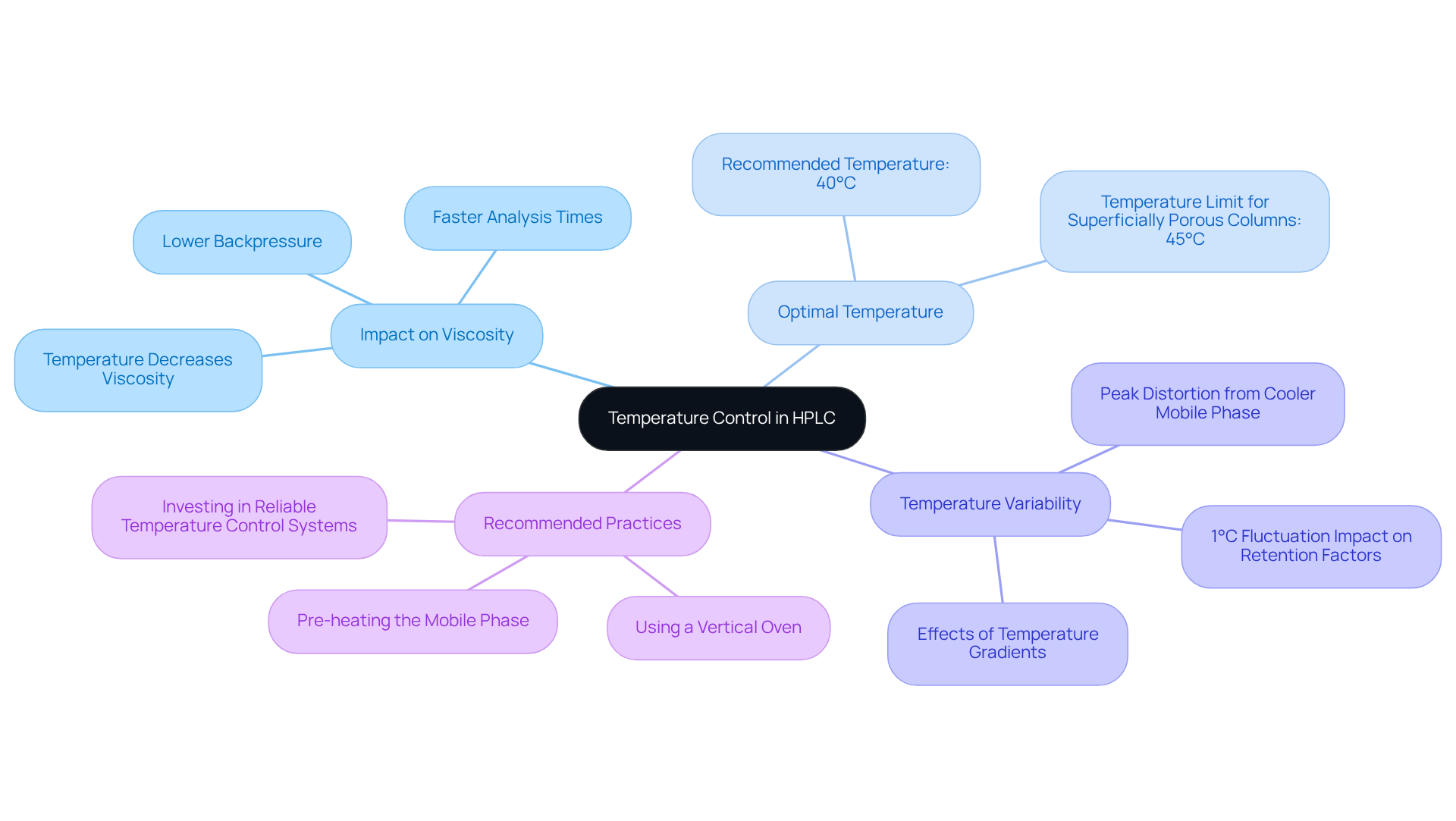
Maintain and Calibrate: Ensure Reliable HPLC Performance
To guarantee reliable performance from high-performance liquid chromatography systems, establishing a robust is crucial. Regular maintenance activities must encompass:
- Cleaning components
- Inspecting for leaks
- Replacing worn parts—particularly piston seals and purge valve frits—which necessitate attention every three to six months.
Calibration should be conducted periodically to confirm that the system operates within specified parameters; recommendations suggest a frequency of every six months for optimal performance. Implementing a structured maintenance schedule not only prevents issues that could compromise the accuracy and reliability of results but also extends the lifespan of the equipment.
For instance, routine maintenance has been shown to significantly improve data quality and operational efficiency in laboratories, as evidenced by case studies that highlight the benefits of proactive care, including the importance of maintaining comprehensive records and conducting regular inspections of components. Additionally, ensuring an adequate supply of fresh seal rinse solution is vital for optimal performance. By adhering to these practices, laboratories can enhance their analytical capabilities and ensure consistent, high-quality outcomes.
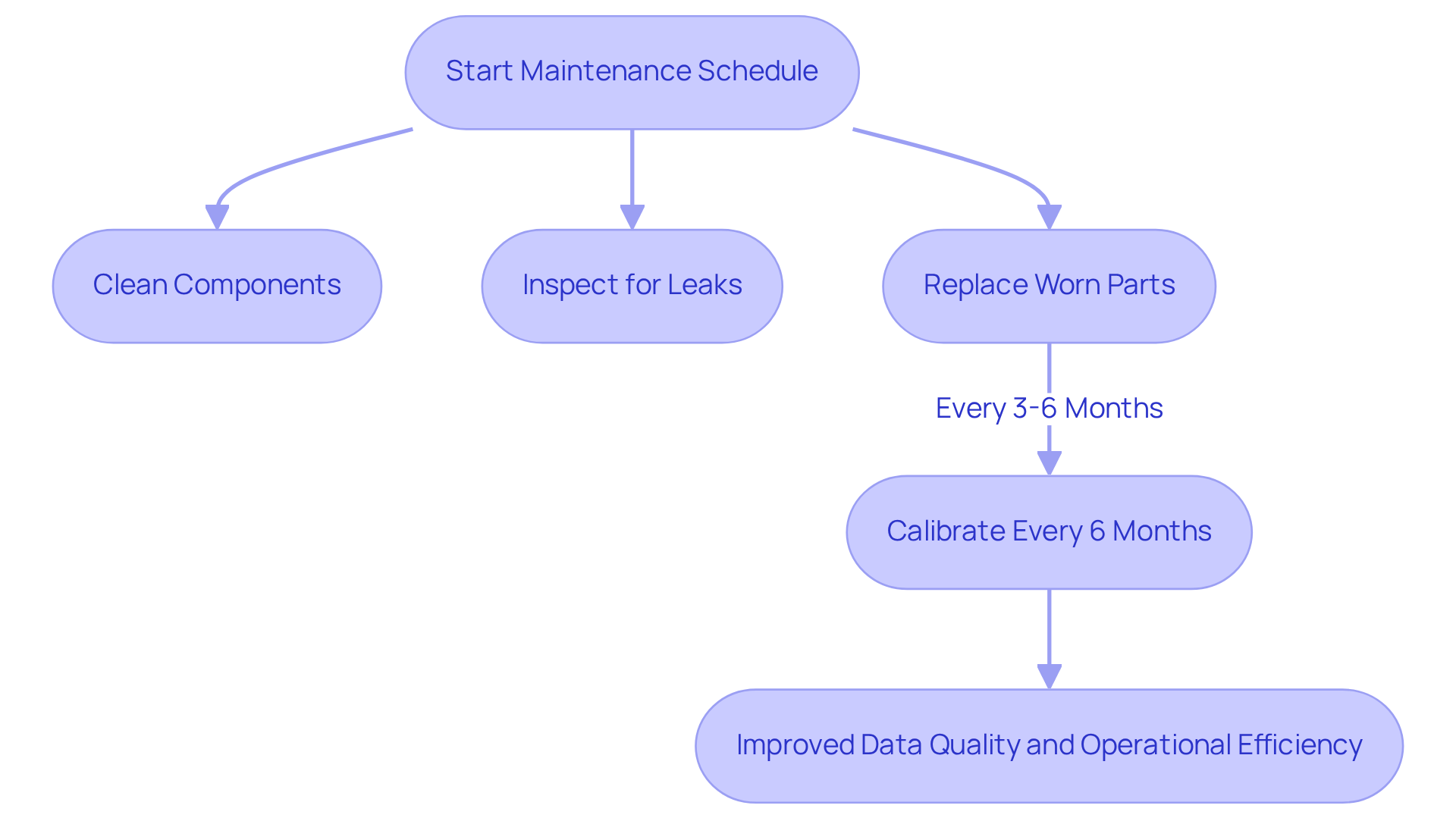
Choose Detectors Wisely: Enhance Monitoring in Preparative HPLC
Choosing the appropriate detector is crucial for enhancing monitoring capabilities in the preparative HPLC column. Common detector types, including UV-Vis, fluorescence, and mass spectrometry, each offer distinct advantages and limitations.
- UV detectors are particularly favored for their simplicity and effectiveness in detecting a wide range of organic compounds, achieving detection limits as low as 0.078 μg/ml.
- In contrast, mass spectrometry provides exceptional sensitivity and specificity, making it ideal for analyzing complex mixtures, with detection limits often reaching the low part-per-billion range.
Recent advancements in high-performance liquid chromatography detection methods have significantly enhanced analytical performance. The incorporation of tandem mass spectrometry (MS/MS) with high-performance liquid chromatography has greatly improved the identification of trace compounds, enabling more thorough structural elucidation. Furthermore, the development of advanced detectors, such as evaporative light scattering detectors (ELSD), has expanded the range of analytes that can be quantified without the necessity for chromophores.
Understanding the is essential in guiding the selection of the most suitable detector. As emphasized by industry experts, the ideal detector should not only provide high sensitivity but also maintain stability and minimize interference from background components. This strategic approach ensures that laboratories can achieve precise and dependable results in their applications using a preparative HPLC column.
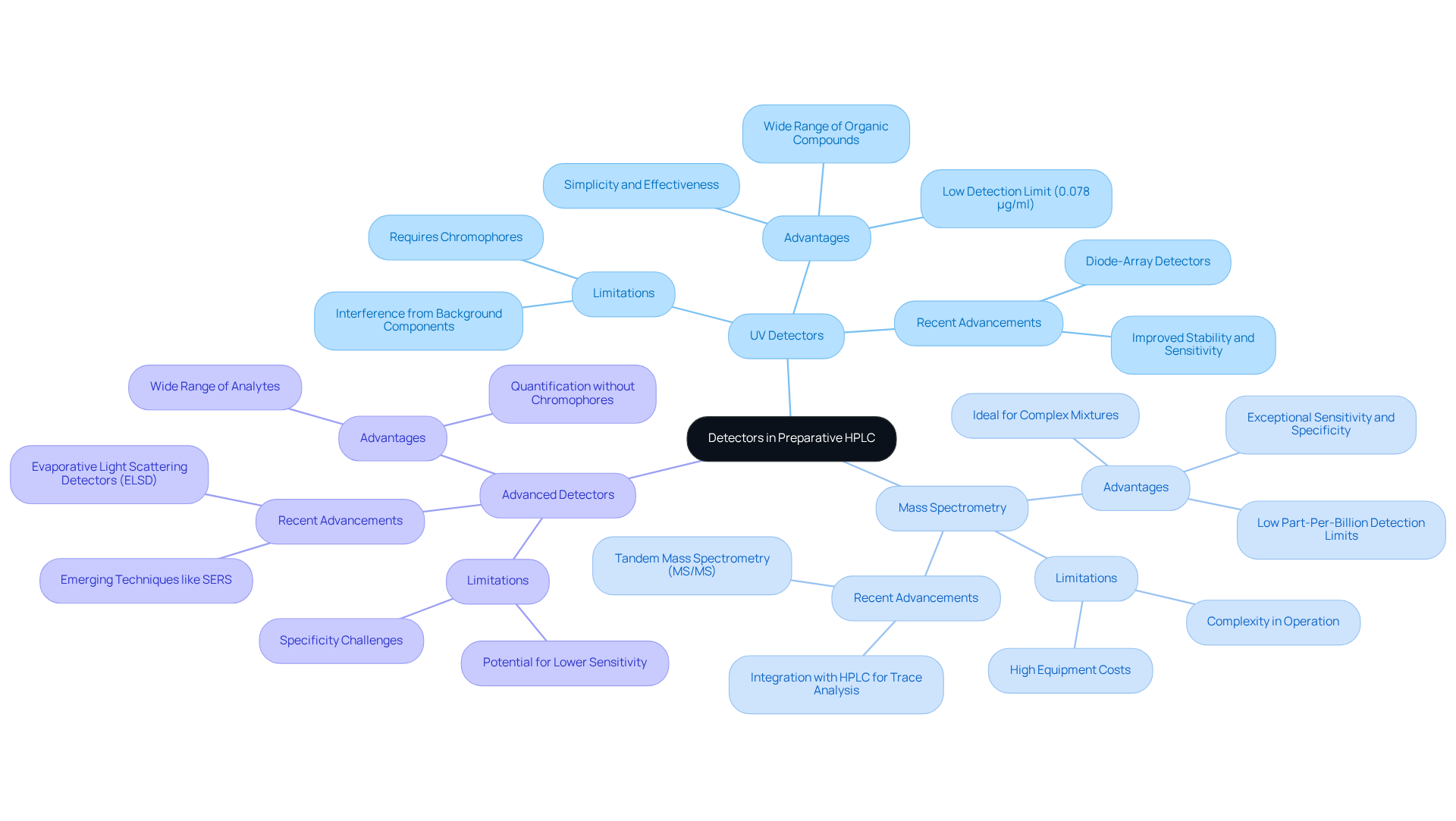
Consult Experts: Leverage Knowledge for Effective HPLC Column Selection
Selecting the right can present significant challenges, particularly when faced with common issues such as peak tailing and ghost peaks. Engaging with chromatography experts is crucial, as their insights can effectively navigate these complexities. Experienced professionals are instrumental in guiding you toward the most appropriate preparative HPLC column tailored to specific applications, analyte characteristics, and desired outcomes.
As Mukesh Kumar, an AR&D Executive, emphasizes, "Expert guidance is essential for enhancing liquid chromatography methods and ensuring precise results."
Furthermore, interacting with technical assistance from manufacturers or knowledgeable peers not only streamlines the selection process but also enhances the overall efficiency and effectiveness of high-performance liquid chromatography techniques. A prime example is the successful testing of flowmeter software in a regulated pharmaceutical laboratory, which illustrates how expert guidance can significantly elevate method efficiency.
Leveraging such expertise is vital for overcoming prevalent HPLC challenges and achieving optimal chromatographic performance.
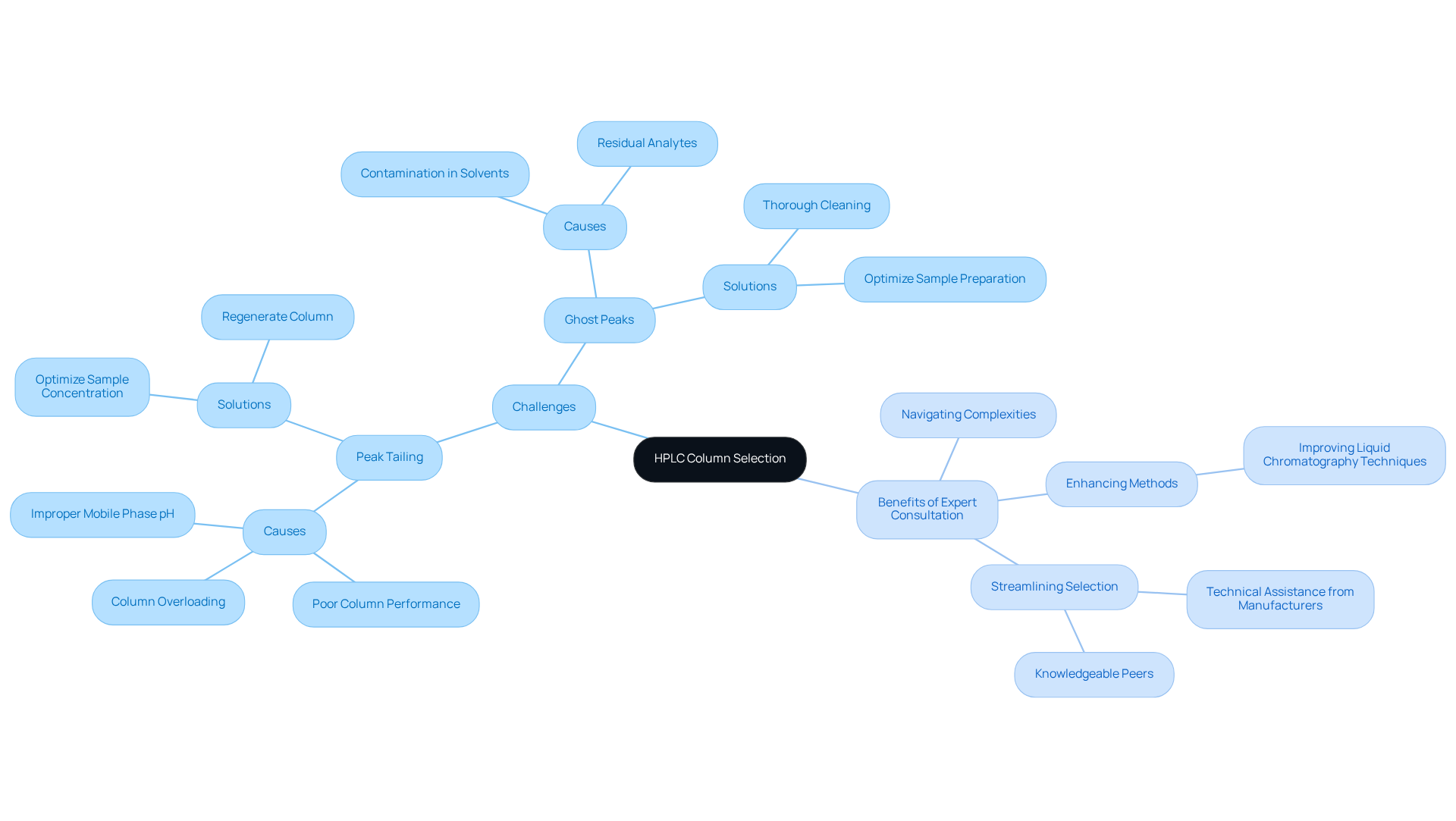
Conclusion
Selecting the right preparative HPLC column is a critical decision that can significantly impact the efficiency and effectiveness of chromatographic separations. This article outlines essential tips for choosing the optimal column, emphasizing the importance of understanding various factors such as:
- Particle size
- Column length
- Stationary phase
- Mobile phase composition
- Flow rate
- Temperature control
- Maintenance
- Detector choice
- The value of expert consultation
Key insights highlight the need to balance particle size for optimal separation without exceeding backpressure limits. The critical role of column length enhances resolution while managing throughput, and selecting the appropriate stationary phase tailored to specific analytes is significant. Furthermore, the composition of the mobile phase, flow rate adjustments, and temperature control are pivotal in achieving consistent and high-quality results. Regular maintenance and calibration, along with careful detector selection, further enhance the reliability of HPLC systems.
In conclusion, the selection of a preparative HPLC column is not merely a technical choice but a strategic decision that requires careful consideration of multiple elements. By leveraging expert knowledge and adhering to best practices, laboratories can optimize their chromatographic processes, ensuring precise and reproducible results that meet the demands of modern scientific research. Emphasizing the importance of these practices will not only improve analytical outcomes but also contribute to the overall advancement of laboratory efficiency and performance.




